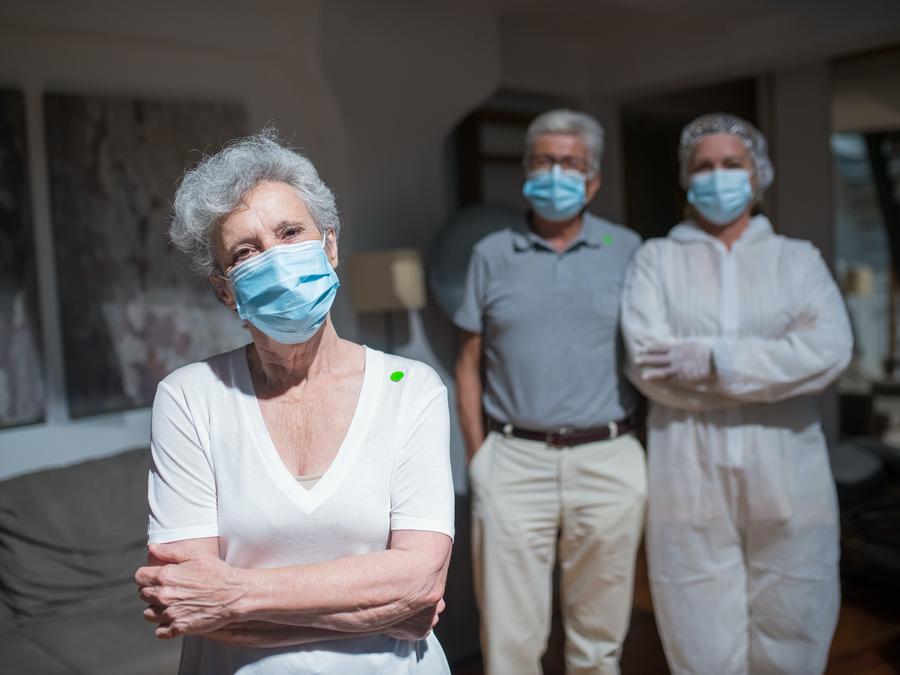Information for Long-Term Care Facilities
Last content update: 4/2/24
Welcome Long-Term Care Facility (LTCF) partners. The resources listed here are for LTCF Administrators, Directors of Nursing (DONs), Infection Prevention (IP) Nurses/IP team members, Directors of Staff Development (DSD), and other LTCF team members that play a role in the prevention and control of COVID-19 infections in LTCFs.
Reporting
Reporting is an essential part of public health response to diseases. Not only is disease reporting required by law, it also helps shape our response as the information is used to detect outbreaks, identify exposures in high-risk settings, and inform the allocation of local resources.
In addition to the guidance on this webpage, LTCFs should refer to the Infectious Disease and Other Reportable Conditions webpage to ensure they are in compliance with all reporting requirements. If you have questions regarding reporting or need to report a disease urgently, please call (408) 885-4214.
What should LTCFs report to Public Health?
- LTCFs should report ≥1 confirmed COVID-19 case in a resident or HCP* to Public Health.
- All COVID-19-related hospitalizations and deaths associated with a LTCF should be reported to Public Health.
*HCP includes any of the following individuals who perform onsite functions: employees; contractors and sub-contractors such as those who deliver goods or perform services onsite; vendors; volunteers and interns; and any other individuals who routinely are onsite at the request of the business or governmental entity.
How can LTCFs report COVID-19 to Public Health?
- Reporting of COVID-19 is completed online through the Shared Portal for Outbreak Tracking (SPOT).
- LTCFs that report COVID-19 cases by phone will be redirected to report the cases through SPOT.
Where can I find more information about COVID-19 reporting requirements?
- LTCFs should refer to the Infectious Disease and Other Reportable Conditions webpage to ensure they are in compliance with all reporting requirements.
- Title 17, California Code of Regulations (CCR) §2500, §2593, §2641.5- 2643.20, and §2800-2812 Reportable Diseases and Conditions.
Shared Portal for Outbreak Tracking (SPOT)
SPOT Resources
- For technical assistance with SPOT, please contact the SPOT Help Desk at [email protected] or call (916) 520-1619.
- For questions, the Provider Response Group (PRG) is available through email at h[email protected].
Health care providers should report influenza, respiratory syncytial virus (RSV) and other respiratory outbreaks in accordance with the information provided within this letter from the Communicable Disease Controller.
This includes the following reporting requirements:
- Influenza due to novel strains should be reported immediately by telephone.
- Influenza outbreaks occurring in high-risk settings with at least one case of laboratory confirmed influenza in a cluster of 2 or more Influenza-like illness (ILI) within a 72 hour period should be reported immediately by telephone.
- Non-influenza respiratory outbreaks, including RSV occurring in high-risk settings with at least one case of a laboratory-confirmed respiratory pathogen other than influenza, in the setting of a cluster or 2 or more of acute respiratory illness within a 72-hour period should be reported immediately by telephone.
To report via telephone, dial (408) 885-4214, select option 3, and ask to speak to the “Nurse of the Day”.
Health care providers should report MDRO and carbapenem resistant organisms in accordance with the information provided within this letter from the Communicable Disease Controller.
This includes the following reporting requirements:
- Colonization or infection of Candida auris should be reported by telephone within one working day of identification.
To report via telephone, dial (408) 885-4214, select option 3, and ask to speak to the “Nurse of the Day."
Respiratory virus guidance
Note: When there is a difference between local, state, and federal guidelines or health orders; or difference with other regulatory agency guidelines, including guidelines for testing, quarantine, and isolation, the most restrictive guideline or order should be followed.
- The guidance on this webpage is non-exhaustive. LTCFs should consult their respective state or federal regulatory or licensing agencies or governing bodies (such as CDPH, CDSS, DHCS) for additional guidance or requirements that may be applicable.
- In the workplace, employers are subject to the Cal/OSHA's COVID-19 Prevention Non-Emergency Regulations or in some workplaces the Cal/OSHA Aerosol Transmissible Diseases (ATD) Standard, and should consult those regulations for additional applicable requirements.
- Health care facilities or LTCFs that are subject to reporting or licensing requirements by the Centers for Medicare and Medicaid Services (CMS) should visit the CMS webpage for additional information or requirements.
What guidance should my LTCF follow?
COVID-19 guidance for LTCFs is differentiated based on whether a facility is considered a Health Care Delivery Facility. A Health Care Delivery Facility is a setting where patient care is provided indoors.
Per the Health Order, a “Health Care Delivery Facility” means a setting where patient care is provided indoors. Health Care Delivery Facilities include hospitals, clinics, surgery centers, dialysis centers, sites that provide inpatient or outpatient health care, skilled nursing facilities, portions of long-term care facilities where nursing care is provided, and other facilities where patient care is provided indoors.
County of Santa Clara, Public Health Department (PHD)
- Health Order Requiring Use of Face Masks in Patient Care Areas of Health Care Delivery Facilities During Designated Winter Respiratory Virus Period; Rescission of Prior Health Orders
- Letter - COVID-19 Isolation and Quarantine Guidance for Congregate Care Settings
- Health Alerts, Advisories, and Updates
California Department of Public Health (CDPH)
- AFL 21-08.9: Guidance on Quarantine for Health Care Personnel (HCP) Exposed to SARS-CoV-2 and Return to Work for HCP with COVID-19
- AFL 23-12: COVID-19 Recommendations for Personal Protective Equipment (PPE), Resident Placement/Movement, and Staffing in Skilled Nursing Facilities
- AFL 23-36: Recommendations for Prevention and Control of COVID-19, Influenza, and Other Respiratory Viral Infections in California Skilled Nursing Facilities
- Recommendations for Prevention and Control of COVID-19, Influenza, and Other Respiratory Viral Infections in California Skilled Nursing Facilities - 2023-24
Center for Disease Control and Prevention (CDC)
- Interim Infection Prevention and Control Recommendations for Healthcare Personnel During the Coronavirus Disease 2019 (COVID-19) Pandemic
- Interim Guidance for Managing Healthcare Personnel with SARS-CoV-2 Infection or Exposure to SARS-CoV-2
*Facilities may use the 213 Resource Request Form to request additional PPE and testing supplies. Send the completed form as an attachment to [email protected].
County of Santa Clara, Public Health Department (PHD)
- Letter - COVID-19 Isolation and Quarantine Guidance for Congregate Care Settings
- Health Alerts, Advisories, and Updates
California Department of Social Services (CDSS)
- PIN 23-13-ASC: Updated COVID-19 Guidance on Vaccinations, Masking, Screening, Testing, Isolation and Quarantine, Visitation, and Infection Control Requirements
*Facilities may use the 213 Resource Request Form to request additional PPE and testing supplies. Send the completed form as an attachment to [email protected].
Quick Links
- COVID-19 Information for ProvidersCOVID-19 Information for the Public
- COVID-19 Vaccine Information for Providers
- Provider Information Notices (PINs) for CCLD-licensed Providers
- All Facilities Letters (AFLs)
- Shared Portal for Outbreak Tracking (SPOT)
- Public Health Orders
- Health Alerts, Advisories, and Updates


